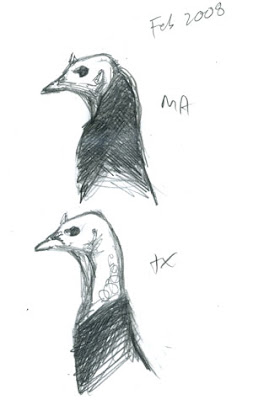Here’s an example of one of the countless thousands of questions that are still out there waiting to be answered about North American birds. I went to Texas in February (for the opening of the fantastic new Clif Moss Nature Education Center of the Corpus Christi Public Library) and I had a chance to see some Wild Turkeys nearby. As expected they had whiter tips on all the body feathers than northeastern birds, but they also seemed thinner and smaller-headed than the Turkeys that frequent my backyard in Massachusetts, and when I got home I immediately saw what the difference was.
The Massachusetts Wild Turkeys have feathering extending all the way up the neck, while the Texas Turkeys have a long stretch of the upper neck bare (here’s a quick sketch I did that first morning at home). This is logical, presumably an adaptation to the cold weather in Massachusetts, but in a quick review of some sources (the BNA account) I found no mention of neck feathering as a geographic difference. I thought maybe it was just a winter feature; maybe the Texas birds had already lost their “winter coat”, and the Massachusetts birds would lose their neck feathers for the summer. They may still do that, but as of today (2 April 2008) they look the same.
As usual, this just brings up more questions: Is this going to be true year-round? What are the patterns of variation? Do all southern birds – Florida, Texas, Arizona – lack neck feathers? Does it change gradually from north to south or is the change more abrupt? and lots more….



Hello David Sibley,
I love your blog, I never knew Wild Turkeys varied so much. I learn so much from you.
Goodbye,
Birdman
Great blog…will visit again.
Hello D. Sibley,
The first question that came to my mind regarding the feather pattern of the southern birds is what is the origin of these birds. There has been one heck of an effort by sportsman’s groups to stock turkeys across North America. So it would be interesting to know if the birds in Texas and your birds at home are descended from local “original” stock or from…? Good Blog, thanks Bart
Hi!
I don’t know much about Turkeys but weren’t they widely (re-)introduced to vast parts of the East? Won’t that possibly affect the amount of variation or mess up a potential clinal change? But findings like yours just scream “look at me, I might be a cryptic species” in the face of birders and are incredibly exciting!
I am looking forward to more information!
Thanks for the comments. Turkeys have been introduced and reintroduced all over the place, so that certainly complicates the picture and you are right to add that to the list of questions. I don’t think there’s really any chance of discovering a cryptic species in Wild Turkey, but this is a pretty distinctive variation and should be fun to try to unravel. And it gives us a reason to pay more attention to Turkeys.
Interesting observation. I took some photos of what I think are Gould’s turkeys in Madera Canyon, AZ in mid-November and they look similar to the Texas turkeys with about half of the neck bare and a thin line of short feathers on the back of the neck up to the nape. Here’s an example:
http://blackbird.smugmug.com/gallery/2439219_KdgAR#223158330_6wK6Z
Philip Kline
Great illustration. I have been an avid bird watcher, as well as a turkey hunter, for many years. I believe what you are seeing here is the effect cold weather has on turkeys. The Texas birds are more relaxed due to the presumably warm weather whereas the Mass. birds neck is more contracted due to the cold. I have seen the same effect on turkeys here in Missouri and Kansas. In the winter even the males seemingly have feathers all the way up to their heads, but in the spring they have long bare brightly colored necks. It is true that feather coloration varies greatly among turkeys throughout the country. Even within a local population there can be variations due to cross breeding among different subspecies, such as those of eastern Kansas (Rio/Eastern Hybrid). Thanks again for all your wonderful books. Adrian Hall
Hi,
i am a 9th grade student and i am studying turkeys i have a couple of questions can you please email me!